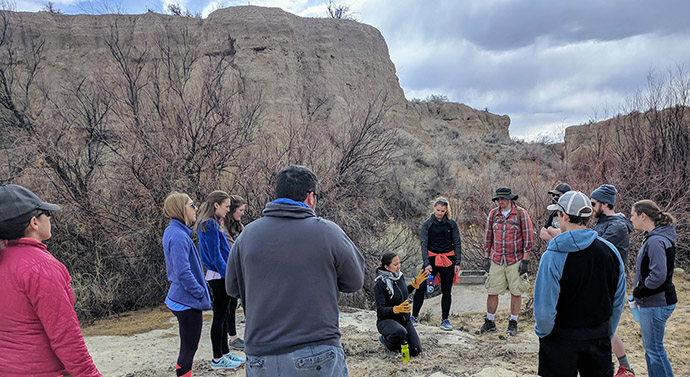On the Ground Learning Over Spring Break:
|
| The CSTPR blog, Prometheus, was revived in 2016 to regularly feature content from CSTPR core faculty, research associates, postdocs, visitors, students and affiliates to serve as a resource for science and technology decision makers. This new dynamism reflects the new energies and pursuits taking place in and around CSTPR. Below we feature one of the recent Prometheus blog posts. |
|
None of us would have guessed that the most impactful part of an eight-day, adventure filled field-trip around the Four Corners area would be a short walk around a mesa in northeastern Arizona. But that was before we met Nicole Horseherder. Let me backup. I have the pleasure of teaching the Advanced Natural Resources Seminar at the Law School this Spring. Initiated by Prof. Charles Wilkinson 30 years ago, this unique seminar examines issues facing a specific geographic area and culminates with a field-trip. Past seminars have studied important watersheds across the southwest, the Greater Yellowstone Ecosystem, and the Grand Canyon. This year, we studied the Colorado Plateau—these canyons and high deserts are home to more national parks and monuments than any place in the world. Native American Tribes hold one-third of the land. From Durango to the shadows of Bears Ears, from Glen Canyon Dam to the south rim of the Grand Canyon, through Monument Valley and the expanses of Hopi and Navajo lands – we racked up over 1,300 miles meeting with federal land managers, Native Americans, environmental organizations, land trusts, and others who shared what they know about this unique landscape. Throughout the semester, 12 law students learned about the area’s history, culture, and current challenges such as a raging public land debate, habitat loss, grazing, increased aridity, electricity production, drilling, and mining. But walking on Nicole’s ancestral lands with her nine year-old son and 14 year-old daughter is what put everything into perspective. Indigenous people have occupied Black Mesa since the 1500s relying on the once vast Navajo Aquifer. Nicole’s family was nomadic into her teens, moving with their sheep and utilizing the Navajo Aquifer. Long after her family settled into permanent homes, her grandmother continued to travel around the mesa with their sheep — sleeping in small hogans. (When we arrived at Nicole’s remote home, her grandmother had just returned from a long trek with her sheep.) Far off the grid, the house is powered by a solar array and battery packs and we found her homeschooled kids busily working on their iPads. The seeps and springs her people relied on for years have all dried up. They now must truck water in for themselves, their horses and sheep, and a large garden. If you ask Nicole why the water has disappeared over the last 20 years, she has a quick answer: the 2,250 megawatt Navajo Generating Station (NGS) and its associated coal mines. The coal plant was built to help push Colorado River water through 300 miles of canals to Phoenix and Tucson. Over the lifetime of the mines, it is estimated that Peabody Coal used 45 billion gallons of aquifer water to run its slurry lines. Peabody still uses an estimated 1 million gallons of Navajo Aquifer water every day. The coal plant is scheduled to be closed in 2019, but Navajo leadership is searching for new buyers for the coal. If the mine remains open, the aquifer will continue to be drained. Regardless, it has little chance of recharging with only ~eight inches of rainfall a year. Climate change has taken a toll, and these lands are now hotter and drier than in recorded history. Yet Nicole and her family are determined to stay; she advocates for closing the mine and replacing those jobs with investments in renewable energy. “Having had the privilege of seeing the land as the Creator left it for us, I know that the wise management of the basic elements of life – land, air, water and the sun – are necessary if we are to fulfill our responsibility to ensure a decent quality of life for the next generation.” After hiking to a former spring site, Nicole invited us into her home for tea and cornbread. Her daughter had made the bread for her recent coming of age ceremony. The intimacy of this moment cannot be fully explained in words. I struggled to think of what gift we could leave besides the abundant research produced by the class and a heartfelt thank you note circulating among the students. Thanks to our emergency contingency planning, we had almost ten gallons of water in our cars. So we left our water at her family’s door step and continued our journey. A little quieter than on our way in. Each one of us processing the multiple layers of complexities that led to Nicole’s battle. The student’s upcoming research papers will be that much richer having experienced how law and policy intersect with the land, water, wildlife, and people of the Colorado Plateau. Alice Madden, alice.madden@colorado.edu |


